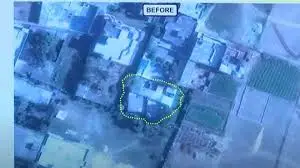Operation Sindoor: Which terror camps in Pakistan, PoK were hit by Indian strikes, and why?

Date: May 7, 2025
Byline: NewsCircuit Special Report
In a decisive response to the brutal terrorist attack in Jammu and Kashmir’s Pahalgam region on April 22, the Indian Armed Forces launched a powerful cross-border operation named Operation Sindoor. The operation, conducted in the early hours of May 7, 2025, targeted multiple terrorist training camps and launchpads located in Pakistan and Pakistan-occupied Kashmir (PoK).
What Triggered Operation Sindoor?
The military action was initiated just weeks after a coordinated terror assault claimed the lives of 26 civilians, including Nepali pilgrims and local Kashmiri residents. The Indian government held Pakistan-based terrorist groups—primarily Jaish-e-Mohammed (JeM) and Lashkar-e-Taiba (LeT)—responsible for the attack. Intelligence reports suggested these groups were operating with impunity in areas controlled by the Pakistani military, prompting India’s swift retaliation.
Key Targets Struck in the Operation
According to high-ranking defense sources, Indian forces hit nine terror camps and support facilities, including:
- Bahawalpur (Punjab, Pakistan): Known to host JeM’s central headquarters, including suspected training facilities and weapons caches.
- Muridke (Punjab, Pakistan): Long believed to be the operational base of LeT, with logistical hubs disguised as educational institutions.
- Muzaffarabad and Kotli (Pakistan-occupied Kashmir): Active recruitment and training centers used to infiltrate militants across the Line of Control (LoC).
- Athmuqam and Chakothi (PoK): Launchpads where terrorists were reportedly stationed before being pushed into Indian territory.
The operation included precision airstrikes and long-range missile launches, planned to minimize civilian casualties while maximizing damage to terrorist infrastructure.
Why Was Operation Sindoor Important?
India has shifted its counterterrorism doctrine over the past decade, emphasizing preemptive, punitive strikes rather than passive defense. Operation Sindoor was not just a retaliation but a statement—India would no longer tolerate the export of terror across its borders.
Government officials described the operation as “surgical yet sweeping,” targeting only high-value terror-related sites while deliberately avoiding civilian zones. “This is not war—it’s justice,” said an Indian military spokesperson.
Casualties and Claims
India’s Statement: Over 70 terrorists were neutralized in the strikes, with multiple camps rendered inoperative. The operation, according to Indian authorities, inflicted a severe blow to the command structure of JeM and LeT.
Pakistan’s Response: Pakistan condemned the strikes, accusing India of violating its sovereignty and claiming that several civilians, including women and children, were killed. However, no independent verification has emerged to confirm this.
Tensions have since escalated, with Islamabad placing its forces on high alert and summoning international envoys to protest what it called “unprovoked aggression.”
Global Reactions
The international community has responded with caution. While nations like the United States, France, and Japan emphasized the need to combat terrorism, they also urged India and Pakistan to exercise restraint and return to diplomatic channels.
The United Nations called for an emergency meeting of the Security Council to discuss the evolving situation in South Asia.
Conclusion: A New Chapter in Counterterrorism?
Operation Sindoor marks a defining moment in India’s evolving counterterrorism strategy. By striking deep inside enemy territory, India sent an unambiguous message: terrorist havens, regardless of geography, will no longer be safe.
As tensions simmer, diplomatic backchannels are reportedly active. Whether this leads to de-escalation or further conflict remains to be seen. But for now, India’s resolve to confront cross-border terrorism appears stronger—and more action-driven—than ever before.






